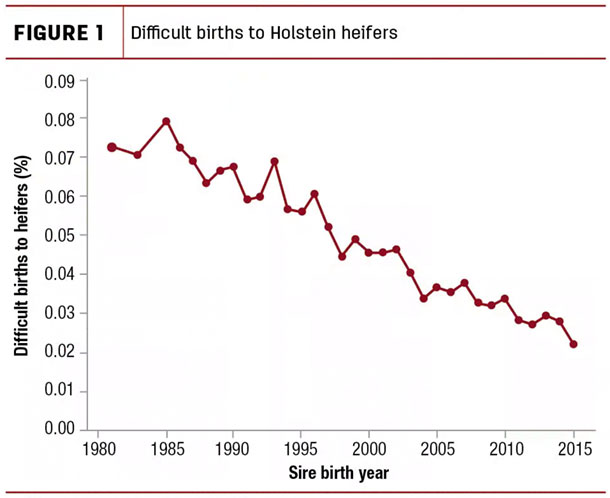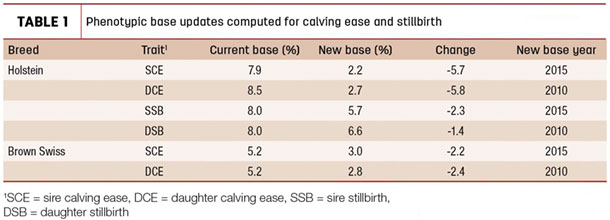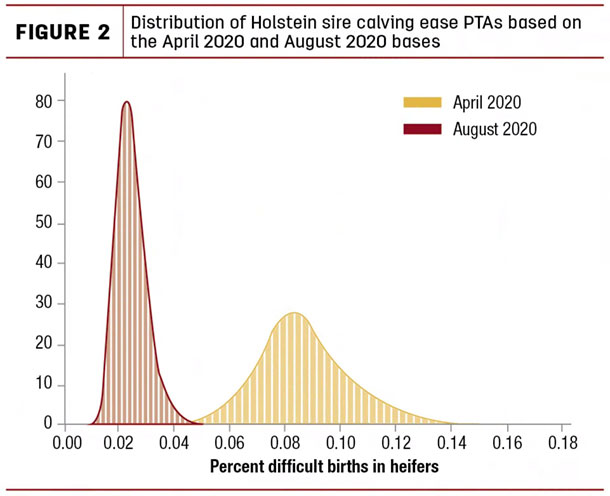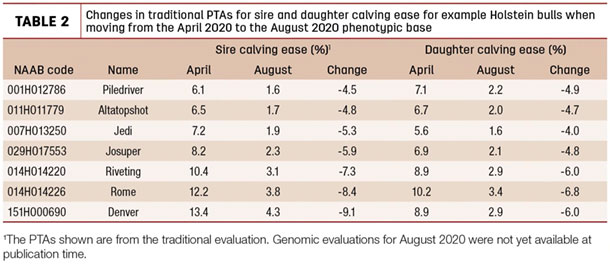In April 2020, the calving traits, along with all other traits, were adjusted to a new genetic base to account for the genetic improvement over the last five years. As calving difficulty has been steadily decreasing, dairy producers were surprised to see higher PTAs for calving ease for some familiar bulls. Some bulls had PTAs of 8% to 10%, yet producers saw only 2% to 3% difficulty after many calvings on their own farms.
The word quickly spread after the April evaluations that there was a mismatch between the calving trait PTAs and the actual rate of dystocia and stillbirth on most farms. The article in the May 2020 CDCB Connection (“What is Going on with Calving Ease?”) assured breeders this mismatch was indeed present, but the bull rankings were correct and the industry was discussing the best way to express the PTAs.
This article explains the new breed average phenotypic bases that will be implemented in August 2020. For brevity, we will focus on calving ease in Holsteins and briefly comment on changes to Brown Swiss calving ease and Holstein stillbirth, too.
Improvement in calving ease
We can see in Figure 1 that the rate of total difficult births to Holstein heifers has decreased substantially over time.

This is exciting news: Selection for better genetics and improvements in calving management practices have clearly resulted in less dystocia and fewer stillbirths. Cows and calves are healthier, and producers obtain more realized income from investing in better genetics given the large economic impact of a difficult birth.
However, despite the declining incidence of difficult births, calving ease PTAs continued to increase. This is because in April we updated the genetic base – but not the phenotypic base. PTAs for the calving traits are expressed on the phenotypic base, as percent of difficult births or percent of stillbirths. The phenotypic base, however, has been kept constant for several years as the result of an industry-wide strategy to focus on genetics. Consequently, PTAs remained relatively constant as well.
After the latest genetic base update, this strategy proved to be confusing and had the potential to mislead breeding decisions. As a result, the industry agreed to adjust the phenotypic base to match the observed, much lower, incidence rates. For the August evaluations, we will adjust the phenotypic base to match the observed incidence rates. In future base changes, both the genetic and the phenotypic bases will be updated. Large changes like we will experience in August are therefore not likely at the next base changes.
New phenotypic base in August
The phenotypic bases will change in August 2020, from the current values to the new values shown in Table 1.

This will cause the average PTA for calving ease and stillbirth to decrease.
Because the incidence rate has decreased, the spread (variation) in the PTAs will decrease, too. There simply aren’t many bulls that lead to a high dystocia rate among offspring.
Figure 2 shows the distribution of traditional PTAs (without genomics) for Sire Calving Ease (SCE) in Holsteins for April and August.

The differences between the two curves are very clear. In April, most Holstein bulls fell between 4% and 12% for SCE. Come August, most Holstein bulls will range from 1% to 4% SCE.
The range of all calving traits for both Holstein and Brown Swiss will have decreased similarly. That means there will be fewer bulls with extreme PTAs on both ends of the scale for calving ease and stillbirth. Changes to the genomic PTAs will be very similar.
The reliabilities of the PTAs will remain the same. The reliability is determined by the amount of information that contributes to the PTA for a bull. When we update the phenotypic base, this does not affect the information going into the PTA. In other words, the number of available daughter and granddaughter records doesn’t change when the base changes. The base change is a mathematical adjustment after the PTA is estimated, which determines how it is expressed.
We’re also making a more subtle change to the stillbirth evaluations. Before August 2020, the stillbirth PTAs were expressed as the percentage of stillbirths to all animals, both heifers and cows. This is different from the calving ease PTAs, which are based only on first-calf heifers. We’re changing stillbirth from all births to heifers calving for the first time so that all calving trait PTAs will have the same interpretation going forward.
An adjustment to Net Merit (NM$) and other indices, such as TPI, must also be made to account for the lower spread among the PTAs. Because the variation in the PTAs is decreasing, both the overall emphasis placed on calving ability (CA$) and individual PTA for NM$ will change. This makes sense. While the calving traits remain economically important, the decreased incidence rate tells us that we are observing significantly less difficult calvings. The weight on these traits can therefore be reduced and instead be placed on traits that require more emphasis.
Preliminary calculations by Dr. Paul VanRaden of Animal Genomics and Improvement Laboratory (AGIL) suggest that the relative emphasis on calving traits in NM$ will decrease from 5% to about 2%. (The final calculations may differ from this slightly.) The approximately 3% emphasis removed from CA$ will be reassigned to other traits, such as early first calving or cow health (HTH$).
How will this affect genetic evaluations for individual bulls?
The ranking of the bulls has always been correct, even with the mismatch experienced in April; however, there may be a change in the differences between bulls in August. In Table 2, the example bulls rank exactly the same on their April and August PTAs, but there’s a 0.7-point difference between Riveting and Rome in August where there was previously a 2.2-point difference.

Figure 2 demonstrates this well. There will be fewer bulls with PTAs in the tail ends of the distribution (extreme PTAs) and more bulls with PTAs around the average. The differences between bulls will therefore become smaller. This also means bulls with higher PTAs in April, for example Denver in Table 2, will see a larger change in their August PTA than bulls with more moderate PTAs.
The changes to the phenotypic base indicate producers that have used a hard PTA cut-off for calving traits can stop using that selection threshold to exclude undesirable bulls. This is especially the case when that hard cut-off was used in combination with a selection index such as $NM or TPI. The selection index will ensure the calving traits are given proper emphasis when ranking bulls.
Does this mean the calving traits are a solved problem?
No, not at all. These results mean we have successfully worked together for many years to get control of a situation that was problematic for many dairy farmers, but it does not mean we can be complacent. The genetic control of calving traits is fairly small (heritability of 3% to 8%), which means that attention at sire selection as well as proper staff training and care in the maternity pen are important to keep dystocia and stillbirth rates low.
The stillbirth rate has decreased, so the phenotypic bases for stillbirth will decrease from 8% for both sire and daughter stillbirth to 5.7% and 6.6%, respectively. It is unlikely, however, that any of us consider a stillbirth rate of 6% to be acceptable. It therefore remains important that we select for animals with favorable PTAs for calving traits. If you select on a selection index that incorporates the calving traits, then that will be taken care of. Indices such as NM$ or TPI will safeguard that the calving traits are still properly accounted for. ![]()
PHOTO: The August sire evaluations will reflect calving trait updates that significantly decrease Sire Calving Ease, Daughter Calving Ease and stillbirths. Staff photo.
Dr. John Cole is the acting research leader of USDA’s Animal Genomics and Improvement Laboratory; Dr. Sophie Eaglen is the international program director at the National Association of Animal Breeders; Dr. Tom Lawlor is the executive director for research and development at Holstein Association USA; and Dr. Ezequiel Nicolazzi is the technical director of the Council on Dairy Cattle Breeding.
John B. Cole is the acting research leader witht the USDA Animal Genomics and Improvement Laboratory
Takeaways
- Calving traits that previously were problematic for many U.S. dairy farmers have been successfully improved through better genetics and management.
- In August, Holstein PTAs will average 2.2% for Sire Calving Ease (SCE) and 2.7% for Daughter Calving Ease (DCE).
- The range of all calving traits will significantly decrease. In August, most Holstein bulls will range from 1% to 4% SCE, while in April most Holstein bulls fell between 4% and 12% SCE.
- Selection thresholds such as “no bull over 8%” are no longer necessary.
- The stillbirth traits will now be expressed as percent stillbirths to heifers, similar to the calving ease traits.






